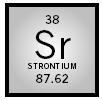Strontium

MELTING POINT:
769°C
BOILING POINT:
1,383°C
DENSITY:
2.54 g/cm
3
MOST COMMON IONS:
Sr
2+
Strontium is the thirty-eighth element in the Periodic Table and the sixteenth most abundant element in Earth's crust. It was first recognized by Adair Crawford in 1790, who named the substance "strontianite," after the Scottish town of Strontian where samples were originally obtained. However, it was Sir Humphrey Davy who actually isolated strontium in elemental form in 1808, using his electrolysis apparatus.
There are four stable isotopes of strontium that are found naturally. In addition there are about twenty radioactive isotopes, including strontium-90, a deadly by-product of nuclear -bomb detonations. The natural forms of strontium are relatively nontoxic. Similar to calcium both physically and chemically, elemental strontium is a soft, shiny metal . Like calcium and other alkaline earth metals, it is easily oxidized and thus not found naturally in its free elemental state. Instead, it almost always is found in the +2 oxidation state, forming such compounds as strontium oxide (SrO), strontium sulfate (SrSO 4 , from the mineral celestite), strontium carbonate (SrCO 3 , from the mineral strontianite), and strontium chloride (SrCl 2 ). Strontium nitrate, Sr(NO 3 ) 2 , is used to produce the brilliant red color seen in some fireworks and signal flares and is also used in making "tracer bullets" that can be seen when fired at night. Other strontium compounds are sometimes used in the manufacture of special glasses. Yet overall, strontium is not a very important element industrially or commercially.
SEE ALSO Davy, Humphry
David A. Dobberpuhl
Bibliography
Heiserman, David L. (1992). Exploring Chemical Elements and Their Compounds. Blue Ridge Summit, PA: Tab Books.
Krebs, Robert E. (1998). The History and Use of Our Earth's Chemical Elements: A Reference Guide. Westport, CT: Greenwood Press.
Comment about this article, ask questions, or add new information about this topic: